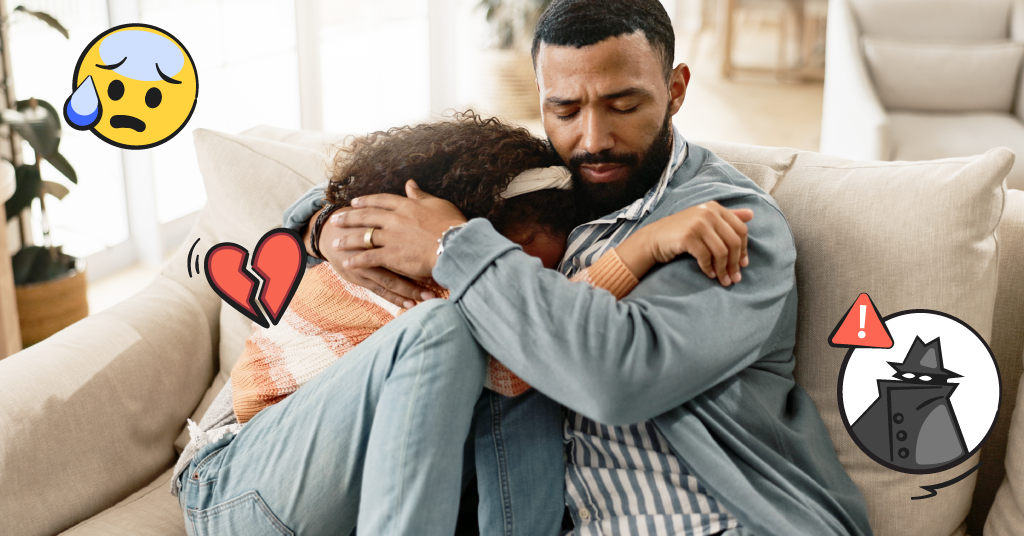
**Please note: This blog post was updated on September 12, 2024.**
Virtual reality (VR) probably seems pretty new, but would it surprise you to learn that VR was invented before the internet? That’s right — today’s kids can’t wait to get their hands on tech that was around in 1968 and available in a 1994 Sega game release. Talk about retro.
Despite being developed decades ago, companies like Oculus and Meta (which owns Oculus) have made VR much more popular. Now, kids can hang out in virtual chat rooms, play their favorite virtual reality games, and tour different parts of the world without ever leaving their homes.
Parents can’t be blamed for wondering what these clunky headsets are and if they really need a spot on the bookshelf. Also, do people know how silly they look fighting invisible bad guys in the living room?
We’re here to answer the question “Is VR safe for kids?” Plus, explain more about what VR is, review the pros and cons of virtual reality for kids, and highlight some of the best VR games. Buckle up!
What Is Virtual Reality
Virtual reality is a technology that combines 3-D simulation with wearable items like gloves and goggles (or a headset). This combination makes users feel like they can interact with a lifelike image or “avatar” (like a digital representation of a person). Today, VR is impressively responsive to users’ human actions, which makes gaming feel even more intense and personal.
There’s a range of different options for using VR headset games. Some systems (like Playstation or Xbox) have created VR headsets that work directly with their game consoles. Other VR systems can use a smartphone as the “software,” and they use a special screen to create a 3-D image that does a pretty good job of replicating your normal field of vision.
Most VR systems also include some type of handheld controller that allows users to take actions in the game they’re playing.
The Pros and Cons of Virtual Reality for Kids
Pros of Virtual Reality for Kids
Even if you’re not rushing out to buy the latest gear, there are some seriously positive benefits to virtual reality for kids that are helpful to understand. Getting familiar with VR tech now could also provide advantages for your child down the road.
- VR can be a more private experience than older styles of gaming systems. Popular, classic games like Mario Kart and Call of Duty can have a communal aspect to gameplay as other kids in the room watch, react, and generally follow along with what’s happening on the screen. Families can play these VR headset games together as a shared indoor activity. Without screencasting capabilities (only available on some systems), VR is a completely individual activity.
- Education may increasingly rely on virtual reality for kids. Companies like National Geographic have produced VR environments that allow kids to virtually explore around the world. Kids who are exposed to and comfortable with VR will be able to adapt to tech-enabled learning environments. VR may also be good for teaching things that might otherwise feel abstract to kids, like space travel and exploration.
- VR systems can help encourage physical activity, even when going outside isn’t an option. Older video game systems might have kids planted on the couch for hours, but VR can actually get you up and moving. Kids are often motivated to stay physically active when it’s part of a fun gaming experience.
- The highly engaging and interactive gameplay in VR can inspire creativity and imagination for kids. This is especially the case for teens and tweens who might not have the opportunity to travel or physically engage in new experiences that are easily offered through VR.
Cons of Virtual Reality for Kids
There are a lot of strong opinions about VR and its potential effects on kids, even though research on its impacts is fairly limited. Below, we’ve tried to highlight some of the most important factors for parents to weigh when considering how to approach VR with their families:
- VR can be a more private experience than older styles of gaming systems. Popular, classic games like Mario Kart and Call of Duty can have a communal aspect to gameplay as other kids in the room watch, react, and generally follow along with what’s happening on the screen. Families can play these games together as a shared indoor activity. Without screencasting capabilities (only available on some systems), VR is a completely individual activity.
- The immersive, sensory experience of VR can make it addicting. Most manufacturers of VR tech and games recommend their products to kids who are at least 12–13 years old.
- Because VR is designed to mimic real-life experiences and interactions, it can make violent or intense and dramatic situations seem very vivid. These in-game experiences could be traumatic or disturbing to young children.
- There’s very little research available on how VR could affect sensory development, or potentially trigger existing conditions. At the very least, VR can cause eye strain and fatigue for kids of any age.
- It's been reported that predators have used the VR space to target kids and groom them in private chat rooms. Meta Quest — one the top dogs in the VR space — has a contact approval feature for child accounts (ages 10-12) so that kids can't call or chat with users unless they've been approved by the parent first. However, kids can still interact with an unapproved contact within certain apps that have messaging features. So, there's no guarantee of keeping your kids from encountering a potential predator on Meta Quest.
Finding the Best Virtual Reality Games for Kids
Understanding VR is only half the story. Keeping track of acceptable game content can be an entirely different challenge. There are a few ways to vet virtual reality games for kids to keep out unacceptable or inappropriate content.
- Check the game’s ratings. The Entertainment Software Rating Board (ESRB) has a wealth of resources for parents looking to learn more about specific games. Their large database is easy to search and provides a game summary plus specific ratings for various kinds of content.
- Look at the game’s objectives and subject matter. If your child wants to play a game with firearms or physical, action-based gameplay, see if there is a good substitute that provides a similar experience with slight changes. For example, instead of a first-person game that promotes direct actions of violence against other people, kids could play a game like Candy Kingdom VR, which is a point-based game with guns that shoot candy.
- Some games can only be played on specific headsets or game consoles, depending on who makes the game. Picking a specific game console with VR capabilities might help you control which games are available to your child.
If you plan to make virtual reality games for kids a regular part of your child’s gaming routine, think about setting basic ground rules for a more positive experience. Here are some of the areas you might want to discuss:
- Time limits for how long games can be played, and when.
- Make sure that the gaming room is set up to keep kids safe when using VR. It’s important to have an open playing area, free from any potential tripping hazards and walls that might hurt the player.
- Rules to encourage inclusivity when friends or family are visiting. This might involve not playing virtual reality games when others want to participate unless there is a way to be inclusive.
- If your kids start to feel sick, tired, or anxious from the VR experience, then it’s time to step away from the game for a bit.
So Are Virtual Reality Games For Kids Really Safe?
VR is definitely here to stay. With most types of technology, the dangers lie in how its used rather than whether it's inherently "bad." Also, it’s pretty likely to be part of your child’s world while growing up, from remote learning to hanging out with friends. A healthy understanding of the tech behind VR, and clear rules around gaming and usage will help make your kid's experience safer.
Read more
Bark helps families manage and protect their children’s digital lives.





